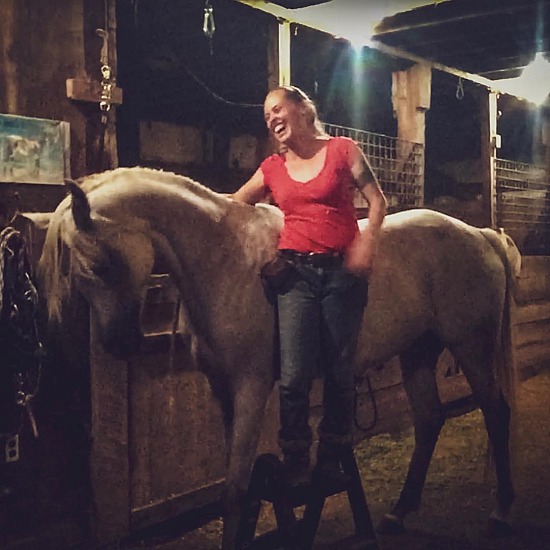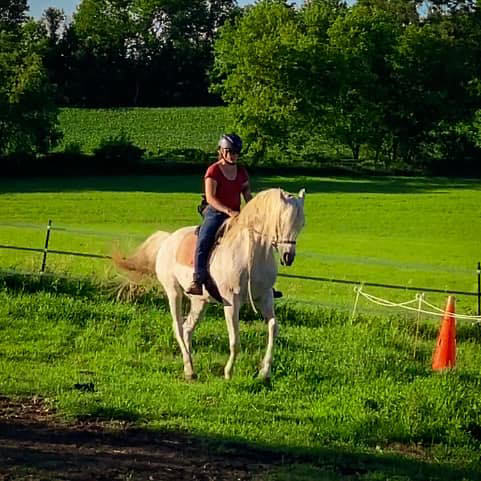Riding
Dressage in the wild
To me, this means approaching a dressage mentality with a tendency to emphasize fluidity and adaptability over prescription. Also working outside using terrain and obstacles as natural variables for better movement capability and capacity.
Cooperative saddling
A horse's response to saddling gives us so much information about their experience and level of comfort with being ridden. Framing the process of saddling as a question gives the horse an opportunity to make a choice about whether they'd like to participate. If they choose not to, it's an indication that they're feeling pain or discomfort somewhere, which might be something to investigate before it becomes a bigger problem. One would think that, given the choice, horses would refuse all the time and no one would ever ride again. However, the more you offer the opportunity to say "no," the more likely it is a horse will say "yes."
Bitless and/or bridleless
When the horse moves in nature without a person, there is nothing in the mouth. Although the esophagus and trachea do connect further down the horse’s throat, a horse does not breathe through the mouth. The horse is an obligate nasal breather. The lips form a closed seal that ensures air moves only through the nasal passages. Breaking the seal (with a bit) changes how the horse breathes, how efficiently they process oxygen, and ultimately how they move.
Bridles in general (bitless, too), also change the way a horse moves (obviously, or we wouldn’t use them). It’s possible for a horse to look successful on the outside, but be contorted on the inside. As much as we can feel from the horse, and as skillful as we are, we can never know better than the horse how to move their own body in a given situation. There is too much variation; on the cellular level, epigenetic changes, individual horse kinematics, breed and inherited characteristics, pre- and post-natal experiences and environment, early socialization, handling, and training, injuries and illness, etc. No human can ever know exactly what the horse is experiencing well enough to make truly appropriate changes by direct manipulation of the horse's body parts.
It's because of these things that I choose to work with my own horses this way, however I don't require clients to be bitless.
equitation support
I’m developing a program based on neuroscience and learning theory for riders who experience bracing, stiffness, or even anxiety in their own bodies when riding. Traditional training does not take an individual horse-and-rider pair’s physiology into consideration, imposing a one-size-fits-all, posture-based structure that's often more detrimental than it is educational. If you're not familiar with some of the terms below, DON'T WORRY! It all makes more sense as we go, and you'll find the words are less important than the experience.
We will explore:
- The basic physiology of breathing and the feedback loop between breathing and affective state
- The connection between the head, ribcage and spine, and pelvis and how it fits into patterns of breathing
- Stability/mobility patterns to challenge balance in the saddle
- Coordinating breathing and movement patterns to make physiological changes on cellular and neurochemical levels
- Creating an environment where the desired effect takes place as a side effect of that environment
- Making an external goal that inherently makes the body organize itself to get the task done
Breathing
- Bring awareness to body in stillness
- Manipulate the sympathetic and parasympathetic nervous systems (each are useful)
- Establish baseline for marking the progress of change
Exercises
- Bring awareness to body in motion
- Establish baseline for movement symmetry (problem-solving)
- Increase proprioception by way of end-of-range movement challenges
- Allow for direct change through indirect means
This program is not discipline-specific; it will help with any kind of riding from trails to Dressage to jumping, and at any level. Some of it can also be done on the ground before trying it in the saddle. These techniques are something to come back to when "it’s not working" or if you'd like greater clarity with a specific problem. Every horse and rider pair is a unique situation, and some of these elements may take longer than others, but an 8-session plan might look something like this:
Session 1: Assessment, Intro to breathing patterns
Session 2: Specific breathing patterns
Session 3: Alternating posting seatbones
Session 4: Rolling the hips backward and forward
Session 5: Sliding side to side across the saddle
Session 6: Twisting alternating seatbones
Session 7: Eye movements
Session 8: Association/dissociation of head, ribcage, and pelvis
Requirements
- Be within 30 minutes of Brooklyn, WI
- Have access to a “safe” horse to ride (“safe” is relative, but horse should be able to be ridden on a loose rein in at least one environment and at least one gait). If you'd like to start out on the ground with your horse in hand, it's best to do this in an area in which your horse is very comfortable.
- Be able to ride with stirrups (to post the trot, but there’s some flexibility with tack and gaits)
- Be comfortable being videoed, and comfortable with me using your video for illustration
- Have an open mind - this is extremely, deceptively simple, but not easy
Do you have questions?
While there’s a structure to learning and to positive reinforcement, there’s no single path to success. Every horse is different, and a lot of horses (and people!) are different on different days. Let me help you make a fun, flexible training plan that celebrates your and your horse’s individuality.

Heather K McManamy
South Central WI
Text welcome at 608-333-6950
